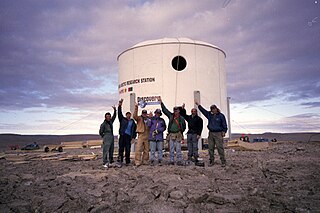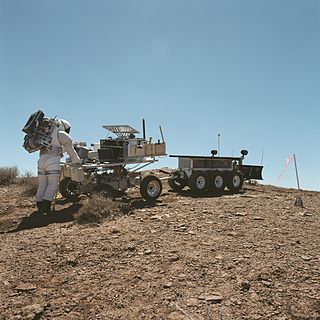The Mars Society is a U.S. registered non-profit organization that leads a worldwide movement, with dozens of chapters, to educate and inform the general public, members of the media, and government representatives about the importance of Mars exploration and the establishment of a permanent human presence on the Red Planet. Inspired by "The Case for Mars" conferences, which were hosted by The Mars Underground at the University of Colorado Boulder, the Mars Society was established by Robert Zubrin and others in 1998 with the goal of educating the public, the media and government on the benefits of exploring Mars, the importance of planning for a humans-to-Mars mission in the coming decades and the need to create a long-term human presence on the Red Planet.

Mars Direct is a proposal for a human mission to Mars which purports to be both cost-effective and possible with current technology. It was originally detailed in a research paper by Martin Marietta engineers Robert Zubrin and David Baker in 1990, and later expanded upon in Zubrin's 1996 book The Case for Mars. It now serves as a staple of Zubrin's speaking engagements and general advocacy as head of the Mars Society, an organization devoted to the colonization of Mars.

The Mars Desert Research Station (MDRS) is the largest and longest-running Mars surface simulation facility in the world, and is one of two simulated Mars analog habitats owned and operated by the Mars Society.

The colonization of Mars has received interest from public space agencies and private corporations, and been extensively explored in science fiction writing, film, and art.

The Flashline Mars Arctic Research Station (FMARS) is the first of two simulated Mars habitats located on Devon Island, Nunavut, Canada, which is owned and operated by the Mars Society. The station is a member of the EU-INTERACT, circumarctic network of currently 89 terrestrial field bases located in northern Europe, Russia, US, Canada, Greenland, Iceland, the Faroe Islands, and Scotland as well as stations in northern alpine areas.
The European Mars Analogue Research Station (Euro-MARS) will be the third in the Mars Society's Analogue Research Stations.

Pascal Lee is co-founder and chairman of the Mars Institute, a planetary scientist at the SETI Institute, and the Principal Investigator of the Haughton-Mars Project (HMP) at NASA Ames Research Center in Mountain View, California. He holds an ME in geology and geophysics from the University of Paris, and a PhD in astronomy and space sciences from Cornell University.

Mars Society Australia (MSA) is an Australian space advocacy organisation, which was formed in 1998.

NASA's Desert Research and Technology Studies is a group of teams which perform an annual series of field trials seeking to demonstrate and test candidate technologies and systems for human exploration of the surface of the Moon, Mars, or other rocky bodies.

The Lab-on-a-Chip Applications Development (LOCAD) element is a set of related lab-on-a-chip projects at NASA. The projects develop integrated lab-on-a-chip products in three areas related to space exploration: Environmental Control and Life Systems Support (ECLSS), Medical Systems, and Remote Exploration. NASA conducts activities related to these projects both at NASA Marshall Space Flight Center and aboard the International Space Station (ISS).

Astrobiology Science and Technology for Exploring Planets (ASTEP) was a program established by NASA to sponsor research projects that advance the technology and techniques used in planetary exploration. The objective was to enable the study of astrobiology and to aid the planning of extraterrestrial exploration missions while prioritizing science, technology, and field campaigns.
The Mars Analog Research Station Program (MARS) is an international effort initiated and spearheaded by The Mars Society to establish a network of prototype research centers where scientists and engineers can live and work as if they were on Mars, to develop the protocols and procedures that will be required for human operations on Mars, and to test equipment that may be carried and used by human missions to the Red Planet.

The Pavilion Lake Research Project (PLRP) is an international, multi-disciplinary, science and exploration effort to explain the origin of freshwater microbialites in Pavilion Lake, British Columbia, Canada.
Human analog missions are activities undertaken on Earth in various environments to simulate aspects of human missions to other worlds, including the Moon, asteroids, and Mars. These remote field tests are performed in locations that are identified based on their physical similarities to the extreme space environments of a target mission. Such activities are undertaken to test hardware and operational concepts in relevant environments.
Terrestrial analogue sites are places on Earth with assumed past or present geological, environmental or biological conditions of a celestial body such as the Moon or Mars. Analogue sites are used in the frame of space exploration to either study geological or biological processes observed on other planets, or to prepare astronauts for surface extra-vehicular activity.
The Austrian Space Forum (OeWF) is an expert organization in the field of analogue research, which researches how humans can prepare on Earth for astronautical exploration of other planets. Since the AustroMars mission in 2006, OeWF has been involved in analog research, developing space suit simulators and also conducting astronautical simulations on Earth. The resulting data is available to researchers from a wide range of disciplines in the Multi-Mission Science Data Archive
A Mars analog habitat is one of several historical, existing or proposed research stations designed to simulate the physical and psychological environment of a Martian exploration mission. These habitats are used to study the equipment and techniques that will be used to analyze the surface of Mars during a future crewed mission, and the simulated isolation of the volunteer inhabitants allows scientists to study the medical and psychosocial effects of long-term space missions. They are often constructed in support of extensive Mars analogs. However, sometimes existing natural places are also valued as Mars analogs. Crewed Mars habitats are featured in most human Mars missions; an alternative may be terraforming or telepresence.
The following outline is provided as an overview of and topical guide to Mars:

Darlene Sze Shien Lim is a NASA geobiologist and exobiologist preparing astronauts for the scientific exploration of the Moon, Deep Space and Mars. Her expertise involves Mars human analog missions, in which extreme landscapes like volcanoes and Arctic deserts serve as physical or operational substitutes for various planetary bodies. She has become a leading public figure for Mars exploration, having presented her missions publicly at academic institutions and public events around the world. She has also discussed her work for various media groups such as NPR, The New York Times, and The Washington Post.











